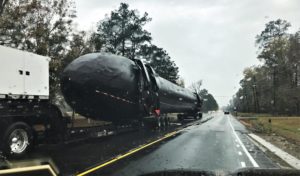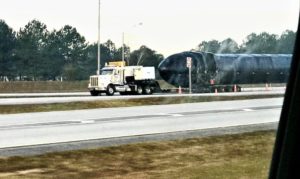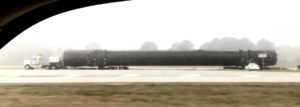
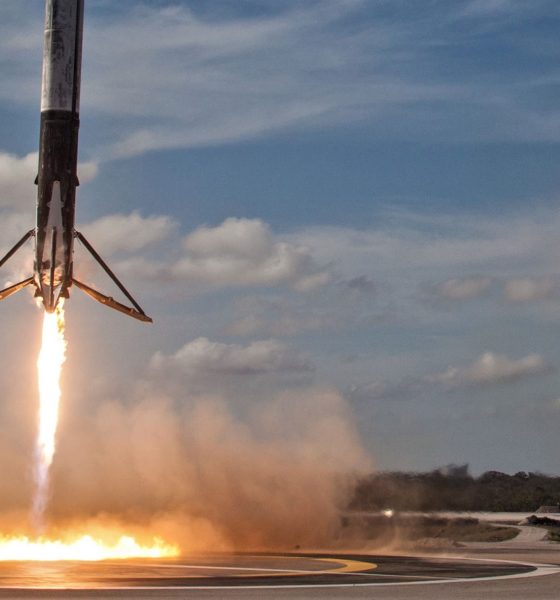
News
SpaceX’s next Falcon Heavy reaches milestone as third booster arrives in FL
A new SpaceX rocket was spotted traveling into Florida yesterday on its way to one of the company’s several Cape Canaveral booster storage and processing hangars. More likely than not, this particular booster is the second Falcon Heavy center core ever built, a heavily modified variant of Falcon 9’s first stage.
With the presumed center core’s arrival, all three Falcon Heavy boosters are now at or near SpaceX Launch Complex 39A, a major step forward for the second flight of the super heavy-lift launch vehicle, currently NET March 2019. Aside from the first stage, it appears that Falcon Heavy Flight 2’s payload fairing may have also arrived at Cape Canaveral around the end of January.

Captured by SpaceX Facebook group member Joshua Murrah on the morning of February 11th, the shrinkwrapped Falcon booster and truck were stopped at a weigh station on the border of Alabama and Florida, a now-common location for core spottings thanks to its adjacency to Mr. Murrah’s daily commute. No more than an 8-10 hour drive from Florida’s East Coast and Kennedy Space Center, the rocket likely arrived at its destination sometime within the last 12 or so hours.
While Falcon Heavy hardware would normally be expected to head straight for SpaceX’s hangar at Pad 39A, the only facility currently capable of launching the triple-booster rocket, the company faces a mild logistical challenge thanks to the terminally delayed launch debut of Crew Dragon. As of now, Crew Dragon, Falcon 9, and 39A’s transporter/erector (T/E) are integrated inside the pad’s hangar, leaving very little space for additional rocket processing as a result of the sheer scale of the T/E. Past photos of SpaceX’s 39A hangar illustrate that it can nominally house 4 or 5 Falcon boosters with ease, but space becomes far more limited once the T/E is rolled inside.
there might actually be juuuust enough room to literally fit them per FH Flight 1 processing pics, but only enough for Falcon Heavy integration if the TE remains outside. Will be very curious to see how SpaceX handles this, it's one hell of a logistical puzzle 😅 pic.twitter.com/D5BFXQnQ3V
— Eric Ralph (@13ericralph31) January 30, 2019
In essence, Falcon Heavy Flight 2 will likely have to wait until Crew Dragon has completed its launch debut before SpaceX technicians and engineers can begin integrating its three boosters and verifying that all is healthy, only the second time SpaceX will have performed those procedures. Crew Dragon’s uncrewed demonstration mission (DM-1) is currently scheduled for NET March 2nd, although there is a high probability that it will slip at least a few more days into March, if not further. Prior to its latest March 2nd launch target, Crew Dragon was expected to launch sometime in mid-to-late January as of December 2018, a date that has effectively remained 30+ days away ever since.
It’s ambiguous what the causes of those delays are and SpaceX and NASA clearly have no interest in directly tackling an explanation, but the most likely reason can be found in a painfully mundane reality: paperwork, worsened by a record-length US goverment shutdown. While both partners are likely culpable in some way, the fact remains that SpaceX has a long history of doing difficult things faster and cheaper than the old guard perceives as possible, while NASA has its own decades-long history of doing difficult things with extreme caution (for better or for worse).
- The second (and third) flight of Falcon Heavy is even closer to reality as the first new side booster heads to Florida after finishing static fire tests in Texas. (Reddit /u/e32revelry)
- SpaceX Facebook group member Joshua Murrah captured two great photos of the second Falcon Heavy side booster to arrive in Florida in the last month. (Joshua Murrah, 01/17/19)
- SpaceX Facebook group member Joshua Murrah also captured what is likely the third Falcon Heavy booster’s Florida arrival. (Joshua Murrah, 02/11/19)
- Falcon Heavy ahead of its inaugural launch. (SpaceX)
With any luck, Crew Dragon will successfully launch into orbit for the first time in the first several days of March, leaving enough buffer for SpaceX to rapidly integrate, checkout, and static-fire Falcon Heavy for an operational launch debut – carrying communications satellite Arabsat 6A – near the end of March. If all goes well, Falcon Heavy’s third launch – the USAF’s second Space Test Program mission (STP-2) – could occur as early as April 2019, potentially just a month after Flight 2.

News
SpaceX shades airline for seeking contract with Amazon’s Starlink rival

SpaceX employees, including its CEO Elon Musk, shaded American Airlines on social media this past weekend due to the company’s reported talks with Amazon’s Starlink rival, Leo.
Starlink has been adopted by several airlines, including United Airlines, Qatar Airways, Hawaiian Airlines, WestJet, Air France, airBaltic, and others. It has gained notoriety as an extremely solid, dependable, and reliable option for airline travel, as traditional options frequently cause users to lose connection to the internet.
Many airlines have made the switch, while others continue to mull the options available to them. American Airlines is one of them.
A report from Bloomberg indicates the airline is thinking of going with a Starlink rival owned by Amazon, called Leo. It was previously referred to as Project Kuiper.
American CEO Robert Isom said (via Bloomberg):
“While there’s Starlink, there are other low-Earth-orbit satellite opportunities that we can look at. We’re making sure that American is going to have what our customers need.”
Isom also said American has been in touch with Amazon about installing Leo on its aircraft, but he would not reveal the status of any discussions with the company.
The report caught the attention of Michael Nicolls, the Vice President of Starlink Engineering at SpaceX, who said:
“Only fly on airlines with good connectivity… and only one source of good connectivity at the moment…”
CEO Elon Musk replied to Nicolls by stating that American Airlines risks losing “a lot of customers if their connectivity solution fails.”
American Airlines will lose a lot of customers if their connectivity solution fails
— Elon Musk (@elonmusk) December 14, 2025
There are over 8,000 Starlink satellites in orbit currently, offering internet coverage in over 150 countries and territories globally. SpaceX expands its array of satellites nearly every week with launches from California and Florida, aiming to offer internet access to everyone across the globe.
Currently, the company is focusing on expanding into new markets, such as Africa and Asia.
News
Tesla Model Y Standard stuns in new range test, besting its Premium siblings
Tesla’s newer vehicles have continued to meet or exceed their EPA estimates. This is a drastic change, as every 2018-2023 model year Tesla that Edmunds assessed did not meet its range estimates.
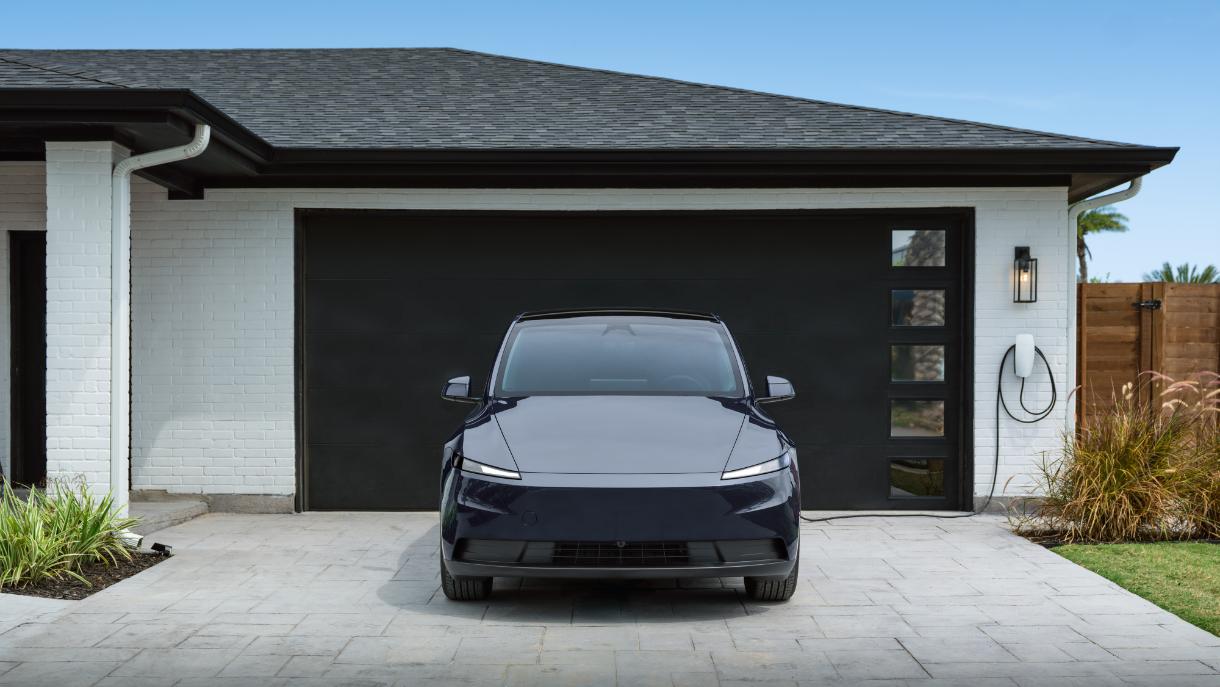
The Tesla Model Y Standard stunned in a new range test performed by automotive media outlet Edmunds, besting all of its Premium siblings that are more expensive and more luxurious in terms of features.
Testing showed the Model Y Standard exceeded its EPA-estimated range rating of 321 miles, as Edmunds said it is the “longest-range Model Y that we’ve ever put on our loop.” In the past, some vehicles have come up short in comparison with EPA ranges; for example, the Model Y’s previous generation vehicle had an EPA-estimated range of 330 miles, but only drove 310.
Additionally, the Launch Series Model Y, the first configuration to be built in the “Juniper” program, landed perfectly on the EPA’s range estimates at 327 miles.
It was also more efficient than Premium offerings, as it utilized just 22.8 kWh to go 100 miles. The Launch Series used 26.8 kWh to travel the same distance.
It is tested using Edmunds’ traditional EV range testing procedure, which follows a strict route of 60 percent city and 40 percent highway driving. The average speed throughout the trip is 40 MPH, and the car is required to stay within 5 MPH of all posted speed limits.
Each car is also put in its most efficient drive setting, and the climate is kept on auto at 72 degrees.
“All of this most accurately represents the real-world driving that owners do day to day,” the publication says.
With this procedure, testing is as consistent as it can get. Of course, there are other factors, like temperature and traffic density. However, one thing is important to note: Tesla’s newer vehicles have continued to meet or exceed their EPA estimates. This is a drastic change, as every 2018-2023 model year Tesla that Edmunds assessed did not meet its range estimates.
Tesla Model Y Standard vs. Tesla Model Y Premium
Tesla’s two Model Y levels both offer a great option for whichever fits your budget. However, when you sit in both cars, you will notice distinct differences between them.
The Premium definitely has a more luxurious feel, while the Standard is stripped of many of the more premium features, like Vegan Leather Interior, acoustic-lined glass, and a better sound system.
You can read our full review of the Model Y Standard below:
Tesla Model Y Standard Full Review: Is it worth the lower price?
News
Xpeng CEO: Tesla FSD 14.2 has developed “near-Level 4” performance
While acknowledging that imperfections remain, the Xpeng CEO said FSD’s current iteration significantly surpasses last year’s capabilities.
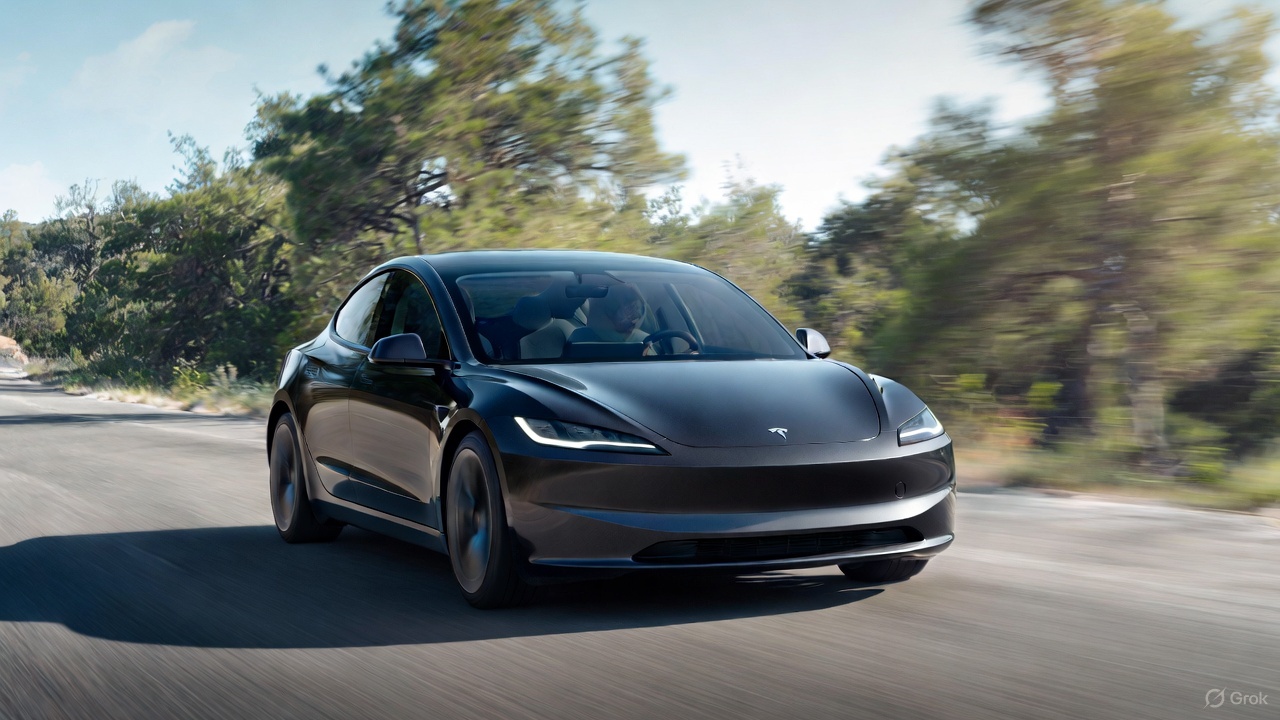
Xpeng CEO He Xiaopeng has offered fresh praise for Tesla’s Full Self-Driving (FSD) system after revisiting Silicon Valley more than a year after his first hands-on experience.
Following extended test drives of Tesla vehicles running the latest FSD software, He stated that the system has made major strides, reinforcing his view that Tesla’s approach to autonomy is indeed the proper path towards autonomy.
Tesla FSD closing in on Level 4 driving
During his visit, He test-drove a Tesla equipped with FSD V14.2. He also rode in a Tesla Robotaxi. Over roughly five hours of driving across Silicon Valley and San Francisco, He said both vehicles delivered consistent and reassuring performance, a notable improvement from his experience a year earlier.
According to He, Tesla’s FSD has evolved from a smooth Level 2 advanced driver assistance system into what he described as a “near-Level 4” experience in terms of capabilities. While acknowledging that imperfections remain, the Xpeng CEO said FSD’s current iteration significantly surpasses last year’s capabilities. He also reiterated his belief that Tesla’s strategy of using the same autonomous software and hardware architecture across private vehicles and robotaxis is the right long-term approach, allowing users to bypass intermediate autonomy stages and move closer to Level 4 functionality.
He previously tested Tesla’s FSD V12.3.6 and Waymo vehicles in California in mid-2024, noting at the time that Waymo performed better in dense urban environments like San Francisco, while Tesla excelled in Silicon Valley and on highways.
Xpeng’s ambitious autonomy roadmap and internal challenge
The Silicon Valley visit also served as a benchmark for Xpeng’s own autonomy ambitions. He stated that Xpeng is looking to improve its VLA autonomous driving system to match the performance of Tesla’s FSD V14.2 within China by August 30, 2026. Xpeng is poised to release its VLA 2.0 smart driving software next quarter, though He cautioned that the initial version will not be able to match FSD V14.2’s capabilities, as noted in a CNEV Post report.
He also added a personal twist to the goal, publicly challenging Xpeng’s autonomous driving team. If the performance target is met by the 2026 deadline, the CEO stated that he will approve the creation of a Chinese-style cafeteria for Xpeng’s Silicon Valley team. If not, Liu Xianming, head of Xpeng’s autonomous driving unit, has pledged to run naked across the Golden Gate Bridge, He noted.
